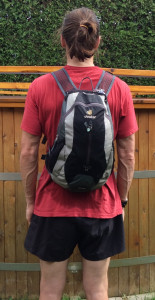During my run back home today, I saw a lady running with a fully loaded Osprey Stratos 34 (2,000 cubic inches – 34 litres) on her back. Osprey makes amazing backpacks, but that particular one on this lady’s back – whom was no more than 125 pounds after a good meal (50 kg), was just too big, to a point where her running stride was clearly impeded by it as the weight of the pack was constantly shifting from one side to the other.
Choosing a backpack to run commute is not just like choosing any pack back. First, you want it as light as possible, even when packed. And, not only does it have to be well-adjusted, but it has to stay well-adjusted WHILE RUNNING. Finally, it must also be slim enough on your back as to not impede your running action, particularly your arm movements. This normally translates into packs that are between 500 and 1,200 cubic inches (10 to 20 litres), depending on your body type and size. This is well below the traditional day hike back pack size, which is around 1,350 cubic inches (22 litres). In summary, good run commuting back packs are:
- light
- slim
- small
- tightly-adjusted to the body
Over the years, companies have built more and more packs that fit these requirements. My personal choice: the Deuter Race X.
******************
[fusion_builder_container hundred_percent=”yes” overflow=”visible”][fusion_builder_row][fusion_builder_column type=”1_1″ background_position=”left top” background_color=”” border_size=”” border_color=”” border_style=”solid” spacing=”yes” background_image=”” background_repeat=”no-repeat” padding=”” margin_top=”0px” margin_bottom=”0px” class=”” id=”” animation_type=”” animation_speed=”0.3″ animation_direction=”left” hide_on_mobile=”no” center_content=”no” min_height=”none”]
At 5’10” and 160 pounds (1,78 m, 73 kg), the Deuter Race X (730 cubic inches – 12 litres) is the perfect run-commuting backpack for me. This bag is light (1.5 pounds – 600 g), and it fits well between my shoulder blades. Even if I load it to its fullest, it rarely weighs more than 10 pounds (4 kg). The shoulder straps are thin but comfortable and well adjusted, and the waiste and chest straps help keeping it snug against my back. Its compact size does not affect my running stride, and my arms can move as freely as if I had nothing on. In winter, it fits just as nicely over all the layers required to run through any kind of nasty weather (see Running Gear Fit to Face A Canadian Winter for more information on these layers).
The Deuter Race X fits me like a glove, but it has other very interesting characteristics. First, it is extremely durable – I have used it constantly, through all kinds of weather, for the past five years, over 6,000 kilometres (4,000 miles). The only thing that let go was the top pocket zipper, which I had fixed by a shoe maker.
[/fusion_builder_column][fusion_builder_column type=”1_1″ background_position=”left top” background_color=”” border_size=”” border_color=”” border_style=”solid” spacing=”yes” background_image=”” background_repeat=”no-repeat” padding=”” margin_top=”0px” margin_bottom=”0px” class=”” id=”” animation_type=”” animation_speed=”0.3″ animation_direction=”left” hide_on_mobile=”no” center_content=”no” min_height=”none”]
The Deuter Race X has another interesting quality…it is very affordable (64$ Cdn at MEC; oddly, it appears to be more expensive in the US, at a cost of around 80$ US). Osprey (Raptor), Gregory (Miwok) and many other companies have bags just as good as this one, but none cheaper (at least in Canada). This bag also comes with an integrated rain cover and is pre-fitted for an hydration pocket (sold separately).
In conclusion, the Deuter Race X is the right size, the right fit and at the right price for most run commuters.
*****************
I mentioned above that I had my pack repaired by a shoe maker after the top pocket zipper gave up on me. I actually get lots of modifications or repairs done on my kit. I am a creature of habit, and I don’t like to change gear that much. If anything breaks or annoys me, I always look for a way to fix it before thinking about getting newer equipment. There are all kinds of good reasons for doing it, but I mainly do it because I don’t like changing things too much! Many years ago, on a long hike, I grabbed the wrong backpack and threw it on. Despite the fact that it was the exact same pack, I knew right away it was not mine, and I did not like that feeling. I then found my pack and put it on; the feeling was amazing, a bit like meeting an old friend you had not seen for a long time. All that to say that I like my gear and that I take super special care of it!
[/fusion_builder_column][fusion_builder_column type=”1_1″ background_position=”left top” background_color=”” border_size=”” border_color=”” border_style=”solid” spacing=”yes” background_image=”” background_repeat=”no-repeat” padding=”” margin_top=”0px” margin_bottom=”0px” class=”” id=”” animation_type=”” animation_speed=”0.3″ animation_direction=”left” hide_on_mobile=”no” center_content=”no” min_height=”none”]
To get modifications or repairs done, I used to go to a normal shoe maker, but lately, I found a shoe maker that specializes in outdoor gear. The cool thing about that, is not only does the kit gets fixed, but it comes back just as good as new. Since gear can become expensive, I strongly encourage you to look for that kind of shop in your area. (if you live in the Ottawa region, check out Atelier hors Piste http://www.atelierhorspiste.com).[/fusion_builder_column][/fusion_builder_row][/fusion_builder_container]

